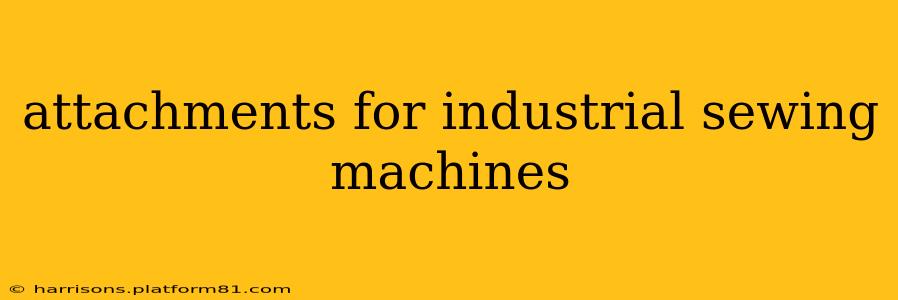Industrial sewing machines are powerful workhorses, capable of handling heavy-duty fabrics and high-volume production. However, their versatility extends far beyond basic straight stitching. A wide array of attachments allows these machines to tackle a diverse range of sewing tasks, significantly increasing efficiency and expanding the types of projects they can handle. This guide explores the various attachments available and their applications.
What Types of Attachments are Available for Industrial Sewing Machines?
The specific attachments available will vary depending on the make and model of your industrial sewing machine. However, several common categories exist:
-
Feed Dogs: These are crucial for consistent fabric feeding. Different types of feed dogs, like walking feet or roller feet, are available for various fabrics and sewing applications. For example, a walking foot is excellent for sewing multiple layers of thick fabric together evenly.
-
Presser Feet: Beyond the standard presser foot, specialized presser feet cater to specific sewing needs. Examples include:
- Rolled Hem Foot: Creates professional-looking rolled hems on lightweight to medium-weight fabrics.
- Blind Hem Foot: Produces almost invisible hems, particularly useful for garments.
- Cording Foot: Allows for the easy application of decorative cording.
- Zipper Foot: Ensures even stitching when sewing zippers.
- Gathering Foot: Gathers fabric smoothly for applications like ruffles or shirring.
-
Stitching Attachments: These attachments modify the stitch created by the machine:
- Decorative Stitch Plates: These plates create different stitch patterns beyond the basic straight stitch. They add decorative elements to your sewing projects.
- Edge Stitching Guides: These ensure consistent distance from the edge when stitching, ideal for professional-looking seams.
-
Specialty Attachments: These attachments tackle specialized sewing tasks:
- Buttonhole Attachment: This attachment creates consistent buttonholes, essential for garment manufacturing.
- Automatic Button Sewing Attachment: This attachment automatically sews buttons onto garments.
- Patching Attachment: Designed specifically for quickly and efficiently patching holes or tears in materials.
- Flange and Binding Foot: Perfect for sewing flat piping or fabric binding onto edges.
How Do I Choose the Right Attachments for My Needs?
Selecting the right attachments depends on the types of projects you frequently undertake. Consider these factors:
-
Fabric Type: Different fabrics require different feed mechanisms and presser feet. Heavy fabrics necessitate robust feed dogs and feet designed for thicker materials.
-
Stitch Type: Do you primarily sew straight seams, or do you require decorative stitches or specialized stitches like blind hems or rolled hems?
-
Project Type: Are you primarily sewing garments, upholstery, or other types of items? This will influence the specific attachments needed.
-
Machine Compatibility: Always confirm that an attachment is compatible with your specific industrial sewing machine model before purchasing.
What are the Benefits of Using Industrial Sewing Machine Attachments?
Utilizing the appropriate attachments offers several key benefits:
-
Increased Efficiency: Specialized attachments significantly speed up sewing processes, increasing productivity.
-
Improved Quality: Attachments ensure consistent stitches and professional-looking finishes.
-
Versatility: Attachments greatly expand the range of projects an industrial sewing machine can handle.
-
Reduced Errors: Attachments minimize human error, leading to fewer mistakes and less wasted material.
Are there different attachments for different brands of industrial sewing machines?
Yes, absolutely. While some universal attachments might exist, many attachments are brand-specific or designed for particular machine models. Always check the manufacturer's specifications to ensure compatibility. Consulting your machine's manual or contacting the manufacturer directly is always recommended.
Where can I find attachments for my industrial sewing machine?
Attachments can often be purchased directly from the manufacturer or authorized dealers of your sewing machine brand. Online retailers specializing in industrial sewing equipment are another excellent source.
What are some common problems with industrial sewing machine attachments?
Common issues can include incorrect installation, wear and tear, and incompatibility with the sewing machine model. Regularly inspect attachments for damage and ensure proper installation to avoid problems. Regular maintenance is key to extending their lifespan and ensuring smooth operation.
By investing in the right attachments, you can unlock the full potential of your industrial sewing machine, enhancing your productivity, and producing high-quality work across a wider range of projects. Remember always to consult your machine's manual for specific instructions and compatibility information.
